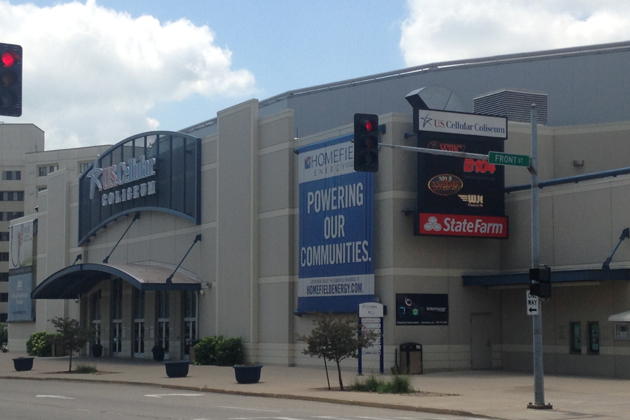
By Joe Ragusa
BLOOMINGTON – The Bloomington City Council approved a $1.4 million purchase of a new video and scoreboard system for the U.S. Cellular Coliseum Monday night.
The video boards from Daktronics would replace video boards bought from BARCO in 2004 for $1.2 million.
Phil Charleston, events manager for Central Illinois Arena Management said BARCO stopped producing video tiles for the Coliseum’s current board in 2012 and Central Illinois Arena Management officials purchased a stockpile of parts for 2-3 years. That stockpile, Charleston said, has run out and the outdoor video board already has two non-working tiles.
The video board software packages only run off of Windows 98 and the only way to play any animation is to play the file in a VCR or DVD player.
Alderman Scott Black was one of the two votes against the new boards. He said Central Illinois Arena Management needs to communicate more about how bad the current boards are.
“I’d like to see CIAM more here and explain whats goings on, what its state of affairs are. I want to see pictures about how bad these video tiles are,” Black said. “Be part of that public discussion because what I have to go back and say, if I support this, explain to someone who has to wait another year for their sewer to be fixed that we’ve just purchased a score board for $1.5 million.”
BARCO stopped producing video tiles for the Coliseum’s current board in 2012 and the video board software packages can only run on Windows 98.
City Manager David Hales said the current boards were a bad investment in hindsight.
“What wasn’t necessarily done is what we’re trying to do today, and that is to come up with the best value for the longest period of time,” Hales said. “Hopefully, if we would’ve purchased Daktronics back then just like Tampa Bay, we wouldn’t be here tonight.”
Daktronics built the video boards at Raymond James Stadium, where the Tampa Bay Buccaneers play, in 1998.
Alderwoman Joni Painter voted in favor of the new boards. She said it doesn’t make much sense to her constituents.
“But since I know that we are contractually obligated to pay for this and I don’t want to add insult to injury by adding a lawsuit on top of this $1.5 million thing we have to pay for, I guess I’ll just have to bow to it,” Painter said.
The vote approving the new boards was 6-2, with Black and alderman Kevin Lower voting against it. Lower wanted to table the discussion on the new video boards indefinitely.
The public comment periods during Bloomington City Council meetings will stay the same, for the most part, under a new ordinance.
City attorney Jeff Jurgens said the proposed ordinance changes some of the language in an attempt to clarify some issues that have come up in the past. The changes clarify that individuals have until five minutes before the scheduled start of a meeting to fill out a public comment card, which will be made available 15 minutes prior to a meeting. Any individual who does not get the chance to speak at a city council meeting will be entitled to a chance at the next meeting of the same type under the new rules. The policy approved Monday night also institute’s public comments at meetings like work sessions, committee meetings and task force meetings.
The measure passed 7-1 with an amendment from Lower making the comment period a minimum of 30 minutes.
Alderman David Sage voted against the amended proposal. He said he doesn’t think the public comment period needs to be longer than a minimum of 15 minutes since most public comment sessions don’t last longer than 15 minutes.
“It seems like we’re trying to fix a problem that doesn’t exist,” Sage said.
The city council can still decide to suspend the time requirement.
Joe Ragusa can be reached at j[email protected].






